IN THIS ISSUE
- A year of wildlife work in review
- More right whale calves, new video
- Bald eagles vs. sandhill cranes
- Are pecans for the birds? You bet
 DNR's Zach Henshaw with a prothonotary warbler (Joe Burnam/DNR)
From prescribed fire to prothonotary warblers, a new report from DNR’s Wildlife Conservation Section explores how the agency – with your support – helped Georgia wildlife in fiscal year 2018.
“Conserving Georgia’s Wildlife” comes in three versions: the online story map linked above, a foldout summary and this comprehensive review of projects statewide.
HOW YOU CAN HELP
The report also spells out how your support is critical. The Wildlife Conservation Section depends largely on fundraisers, grants and donations. State funds make up less than 5 percent of the section’s research and conservation budget.
How can you support this important work?
Top
 A right whale calf -- no. 7 -- among dolphins (Sea to Shore Alliance/NOAA Permit 20556-01)
After a dismal year of no calves, North Atlantic right whales are making headlines this winter with seven calves spotted off the Georgia and Florida coast, the endangered species’ only known calving grounds.
That’s good news. But it does not signal that all is well with these imperiled giants.
DNR senior wildlife biologist Clay George says the species, estimated at only about 425 whales, requires approximately 20 calves per year to grow. The last time the count was that high was in 2013, with 20 calves.
The recent decline in calving is exacerbated by continuing high rates of mortality and injury from vessel strikes and entanglements in commercial fishing rope.
Of course, seven still beats zero. And although calving usually peaks in February, there is hope a few more calves are seen before survey flights in the Southeast end March 31.
GIVE RIGHT WHALES ROOM
Right whales are critically endangered, and for moms with calves this is a time for nursing and bonding. People should give them their space, for the safety of all.
It’s also illegal to be within 500 yards – five football fields – of a right whale. Boaters who find themselves closer than 500 yards should move away as soon as safely possible.
If you see a right whale, call 877-942-5343 (877-WHALE-HELP) or 800-272-8363 (1-800-2-SAVE-ME).
Top
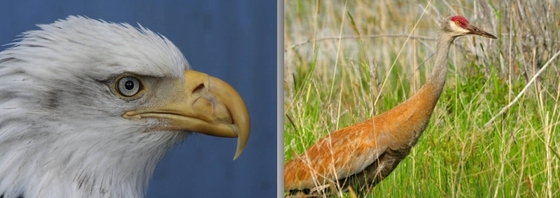 Bald eagle (left); sandhill crane (USFWS)
By DR. BOB SARGENT
Wildlife Conservation Section
Sandhill cranes might look too big for bald eagles to attack. Just don’t tell the eagles that.
Ben Thompson, president of Ocmulgee Audubon Society in Macon, saw this unexpected predator-prey match-up involving a flock of cranes near Montezuma.
“About 3 p.m., a mature bald eagle flew over," spooking the cranes into the air, Thompson texted in late December. “The eagle dove at the flock and took a crane to the ground.”
Another day, he saw an eagle eating a dead crane. Noting that eagles and an estimated 5,000 cranes were still at the site then, he wrote, “It is a daily occurrence that the eagles harass the cranes.”
For about three months each winter, massive flocks of tawny-colored greater sandhill cranes move through or reside in Georgia, foraging in low-lying farm fields in rural parts of the southern Coastal Plain. Birdwatchers are eager to see the leggy, 4-foot-tall birds with crimson caps. Apparently so is our national symbol.
Although fish can comprise 75 percent or more of their diet during the year, bald eagles are opportunistic hunters, feeding on more than 60 species of vertebrates. The list includes crabs, turtles, snakes, raccoons, carrion and birds, especially ducks and coots.
Slow-moving birds such as herons and egrets are often targeted, although these large birds with sword-like bills can be formidable. Cranes are a risky meal, too. But when potential prey gather in large numbers in a relatively small area – i.e., a flock of cranes in a former cornfield – eagles hear dinner bells.
Also, many bald eagles that nest in the north spend the winter in Georgia waiting for their home lakes to thaw. The combination creates a perfect biological storm: large flocks of slow-moving cranes and a substantial increase in the state’s bald eagle population.
For Thompson and others with an eye on birds, it’s a storm worth witnessing.
DID YOU KNOW?
Georgia sees two subspecies of sandhill cranes, greater and Florida. Greater sandhill cranes breed from British Columbia to northern California and east to central Wisconsin, southern Michigan and Ontario. The Great Lakes population winters in the southeastern U.S., especially in Florida and in southern Georgia. Florida sandhill cranes live year-round in Florida and in the Okefenokee Swamp in Georgia.
Top
 A gopher frog egg mass at Sandhills WMA (John Jensen/DNR)
Good news for gopher frogs.
So far this winter, DNR senior wildlife biologist John Jensen has found almost 40 egg masses laid by the rare frogs in ponds at Sandhills Wildlife Management Area.
Scientists struggled to find any at the middle Georgia WMA the last few years.
But what is almost as exciting, Jensen said, is that five of the egg masses were in a wetland DNR built to add breeding habitat for gopher frogs.
“I could be wrong, but I think this is a first anywhere in their range this has been attempted. And it worked without stocking them. We built the wetland and they found it.”
Now found only in Georgia, Florida, Alabama and the Carolinas, the species is state-listed as rare and known in Georgia from only 10 sites. The main problem is habitat loss. Gopher frogs depend on intact sandhill habitats, where adults survive in the burrows of their namesake host, the gopher tortoise. Yet the frogs also require fishless wetlands where they breed and their tadpoles develop.
Researcher Dr. Joyce Klaus recorded a male gopher frog calling at the Sandhills artificial wetland two years ago. Recently, their snore-like calls filled the air at the WMA ponds.
Other potential breeding sites from Fort Benning near Columbus to Alapaha River Wildlife Management Area near Ocilla are being checked.
“Hopefully this is just the beginning of a boom year,” Jensen said.
Top
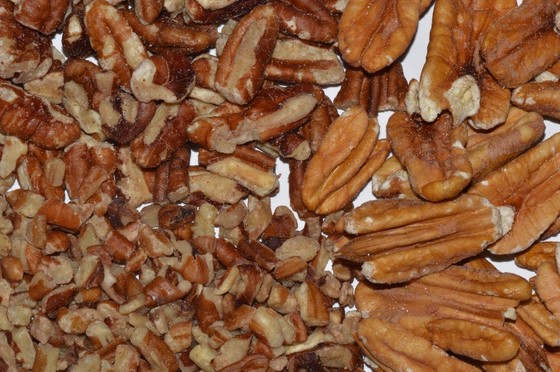 In pieces and halves, pecans will draw birds (Terry W. Johnson)
By TERRY W. JOHNSON
We don’t know when humans discovered that pecans are great to eat. But we do know that Native Americans know the food value of this native nut.
Today, no native North American nut tree has been selectively bred more often. Georgians love our pecans, as snacks and in tasty casseroles, pies and candies.
However, it is a little-known fact that backyard birds love them, too. Pecans are rarely fed to wild birds or even mentioned in books about bird feeding.
As such, I am convinced pecans are one of the most underutilized wild bird foods. …
Read Terry’s column to learn about adding pecans to your feeder menu.
Terry W. Johnson is a retired DNR program manager and executive director of TERN, the Wildlife Conservation Section’s friends group. Read more columns, Terry’s Backyard Wildlife Connection blog and his book “A journey of discovery: Monroe County outdoors.” (Permission is required to reprint this column.)
Top
 Installing a nest insert at Silver Lake WMA (DNR)
In southwest Georgia, endangered woodpeckers hammered by Hurricane Michael are receiving some crucial help from the National Fish and Wildlife Foundation.
Woodlands on what is now Silver Lake Wildlife Management Area have been a refuge for red-cockaded woodpeckers for decades. But, as was the case across southwest Georgia and the Florida Panhandle, neither the WMA nor the woodpeckers were spared when Michael hit in October.
Winds topping 110 mph destroyed almost half of Silver Lake’s 272 pines with woodpecker nest cavities and downed hundreds more trees, clogging DNR's ability to conduct prescribed fires to restore habitat.
In the wake of the hurricane, DNR quickly developed a plan to add nest cavities and reduce woody debris to stabilize the WMA's red-cockaded woodpecker population. But the agency lacked funding to fully put the plan into practice.
That's when the National Fish and Wildlife Foundation provided a nearly $100,000 grant funded by Southern Company and International Paper, two partners with deep roots at Silver Lake.
Read more.
WORK UPDATE
Storm debris has been removed from 39 red-cockaded woodpecker nest clusters and along 10-plus miles of interior roads at Silver Lake. Also, nest cavity trees are being marked by GPS to update WMA management maps.
Top
 The two eaglets in the bald eagle nest live-streamed from Berry College have died within days of each other, the oldest – dubbed B12 – dying this week. The college has consulted with DNR’s Wildlife Conservation Section and advised viewers that interfering with the nest could risk injury to the parents and even cause them to abandon the nest. Watch this Berry Q&A on the eagles.
A pair of ospreys has been hanging out at the nest live-streamed at The Landings near Savannah. Last year, the ospreys' first egg was laid on March 8.
Georgia lawmakers are mid-way through the 40-day General Assembly. Track wildlife and conservation bills via Georgia Conservancy’s website and email updates.
Add trispot darters to the Endangered Species list. Recognized as threatened last month, these small fish – 2.3 inches max – are found in parts of the Coosa River basin in north Georgia, north Alabama and southeastern Tennessee.
A white shark tagged by Ocearch this week is nicknamed Brunswick, for the Georgia city. Ocearch is tagging and tracking sharks on the continental shelf along South Carolina, Georgia and Florida, where concentrations of great whites have been documented in winter.
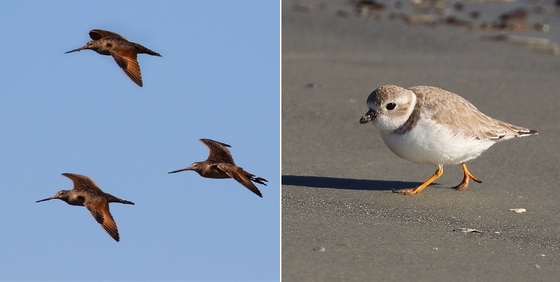 Marbled godwits and a piping plover at St. Catherines (Dan Vickers)
The annual mid-winter shorebird count organized by DNR reported about 62,000 shorebirds along Georgia beaches last month. The count involved some 50 volunteers, with dunlin ranking the most-seen species -- an estimated 35,000.
For young birders and artists, the upcoming Youth Birding Competition and T-shirt Art Contest are fun, free ways to test their skills and learn new ones. The DNR events combine a 24-hour birdathon with an art contest, banquet and wildlife show. Deadlines and details.
The Youth Christmas Bird Count at Charlie Elliott Wildlife Center was a flying success Jan. 12. Almost 20 children – most new to birding – teamed with leaders and other adults to find 46 species, including Bonaparte’s gull and brown creeper.
Exotic invasives such as Bradford pear, tree of Heaven and Chinese privet were treated this month at Sweetwater Creek State Park by prescribed fire crews from Wildlife Conservation and the State Parks and Historic Sites Division. The work, conducted when the weather isn't prime for burning, is helping restore woodlands at the park and draw attention to issues posed by invasive species.
Top
 2018 Forestry for Wildlife partners with Gov. Kemp and DNR leaders
Gov. Brian Kemp and DNR leaders recognized corporate forest landowners Georgia Power, Weyerhaeuser and CatchMark Timber Trust for stewardship and land management practices benefiting wildlife across the state. The three are the 2018 partners in DNR’s Forestry for Wildlife Partnership.
The North Georgia Prescribed Fire Council meeting has been rescheduled for June 6 at Chattahoochee Technical College in Jasper. The meeting, a first for the region, was set for Feb. 7 before the partial government shutdown scrambled plans.
Recreation fees are changing at 18 sites on the Chattahoochee-Oconee National Forests starting March 15. Most will go up slightly. Forest Supervisor Betty Jewett said fees “help protect the land and enhance high-quality recreation opportunities.”
With spring near, it's time to go fish Georgia! 2019 regulations are online, through the Outdoors GA app (free for iPhone or Android users) and at license vendors. Also sign up for fishing updates and follow the weekly fishing blog.
Names in the news: Albany’s Jeff “Bodine” Sinyard is the new chair of the state's Board of Natural Resources. The former Dougherty County Commission chairman has served on the board since 2014 and last year as vice chair. Cpl. Quinn Fogle is DNR's 2018 Investigative Game Warden of the Year. Assigned to Early County, Fogle’s top case last year started with a poached deer posted on social media and ended with 10 suspects charged with 83 wildlife violations, plus charges in a felony drug case and details that helped Alabama deputies solve the thefts of golf carts and a trailer. Ornithologist Dr. Tom Cade, co-founder of The Peregrine Fund and instrumental in re-establishing peregrine falcons in the eastern U.S., died at age 91 on Feb. 6 (New York Times obituary). Tyler Hutchins of Demorest was not only one of 33 Georgia Bass Slam anglers in 2018, he was drawn this week to receive the program’s grand prize. Bass Slam recognition involves catching at least five of the state’s 10 black bass species in a year.
COMING UP
March 2 – Georgia Native Plant Symposium, Middle Georgia State University, Macon
-- Creepy Crawly Day, Dunwoody Library, Dunwoody
March 8-10 -- Environmental Education Alliance of Georgia annual conference, Albany (register by March 4)
March 9-10 -- Claxton Rattlesnake and Wildlife Festival, Hagan
March 14-16 -- Fitzgerald Wild Chicken Festival, Fitzgerald
March 16 – Banff Mountain Film Festival, Ferst Center for the Arts, Georgia Tech
March 22-24 – Confluence (Georgia Adopt-A-Stream volunteer water-quality monitoring conference), Unicoi State Park and Lodge, Helen
April 13-May 19 – 2019 Atlanta Bird Fest, Atlanta Audubon Society
April 24-25 – Identification, mapping, control of invasive pests, UGA, Tifton
May 3 -- Wild for Georgia (The Nature Conservancy), 7-11 p.m., Piedmont Park, Atlanta
May 18 – Keeping Georgia Wild Family Festival, Charlie Elliott Wildlife Center, Mansfield
 WHAT YOU MISSED …
In the previous Georgia Wild:
- A biologist's longleaf legacy
- Right whale sightings stir hope
- If you give a nuthatch a tool
- Wild ways you helped wildlife
Top
"Rare woodpeckers get emergency post-Michael help," The Albany Herald. Also: SaportaReport.
"Closed north Georgia cave opens for research, exploration," Times Free Press (Chattanooga, Tenn.)
"Youth invited to enter Youth Birding T-shirt Art Contest," WNEG-FM (93.1, Toccoa)
"Golden eagle trapped last year has returned to area," Rome News-Tribune
"ESA changes could hinder hellbender conservation," Mountain Xpress (Asheville, N.C.)
"Fund to help conservation, species in north Alabama," Alabama NewsCenter
"Conservation project paves way to caving, hiking, more," Times Free Press (Chattanooga, Tenn.)
"Declines in suburban birds linked to nonnative plants," Smithsonian National Zoo and Conservation Biology Institute
"Corps team protects threatened species" at Donalsonville airport, U.S. Army Corps of Engineers
"Dragonflies embark on multi-generational migration each year," Smithsonian
"Senate passed decade’s biggest public lands package," The Washington Post
"Southeast receives fraction of funding for rare species," Times Free Press (Chattanooga, Tenn.)
"Flying squirrels go pink in ultraviolet," EarthSky. Study (Journal of Mammalogy).
"How one heatwave killed 'third' of a bat species in Australia," BBC
"Top 10 most bizarre amphibians, reptiles in Ecuador," Tropical Herping
Top
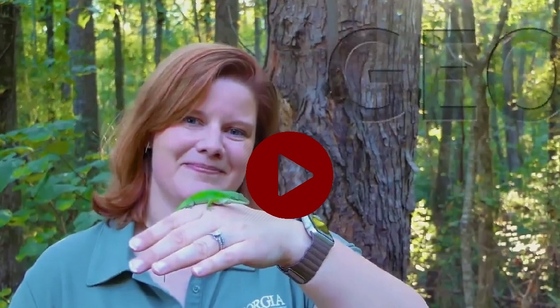 VIDEO AND AUDIO
"Georgia Wild: lizards," DNR (also on Facebook)
"On Second Thought" interview about North Atlantic right whales with DNR's Clay George, Georgia Public Broadcasting
"Hubbard Elementary class builds homes for 600 bats," WMAZ-TV (13, Macon). Article.
"#GoodFire on Chattahoochee-Oconee National Forests," U.S. Forest Service
"Examining owl pellets," BirdNote
"Southern salamander discovered as new species," Georgia Public Broadcasting
Top
 DNR’s Killian Farrell holds a young indigo found on coastal state lands. (Robert Horan/DNR)
As a federally threatened species, eastern indigo snakes are obviously rare. But last month the DNR Game Management Section’s southeast Georgia prescribed fire crew found not one, but two indigos – including a young one – while prepping a state lands sandhills area for a burn. The young indigo was less than a year old, a welcomed sign of the species reproducing at the site. Both snakes were measured, PIT-tagged for future identification and added to DNR’s database. Eastern indigos are the longest snake in North America, growing more than 8 feet long. They prey on many animals, including venomous snakes such as rattlers.
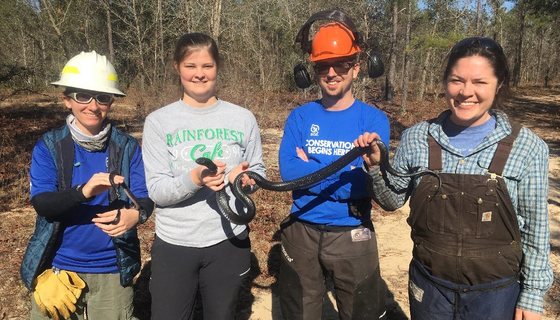 With indigos, from left, Killian, Shannon Swearingen, Ian Lynch and Emma Stanley. (Robert Horan/DNR)
Masthead: Right whale No. 2791 and her calf swim through cannonball jellyfish about 10 nautical miles of Fernandina Beach, Fa. (Florida FWC/NOAA permit 20556-01_20190106)
Top
|